Surfing rules
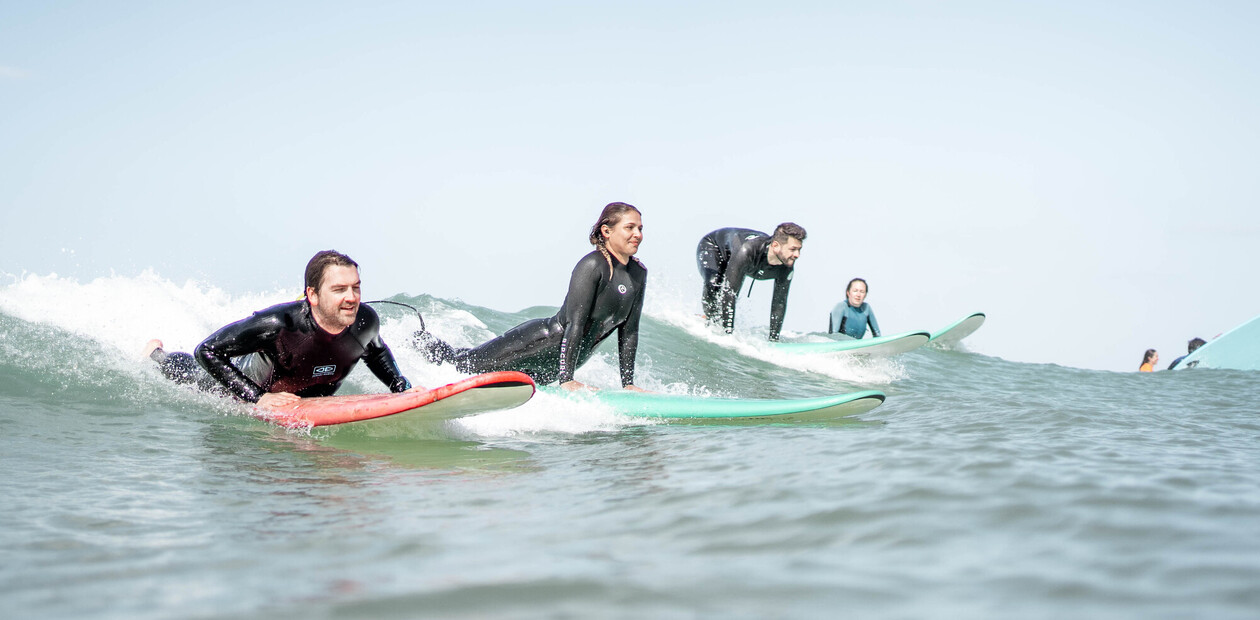
- Introduction: Why are surfing rules important?
- Importance of surf etiquette
- Effects of breaking the rules
- Excursus: What is a line-up?
- Surfing in the line-up - these are the rules
- These are the 14 most important tips on surfing etiquette:
- 1. don't drop in - observe the rules of right of way when surfing
- 2. apologizing - one of the most important surfing rules in the line-up
- This is NOT the way to do it
- 3. greet the other surfers in the line-up
- 4. communicate with the other surfers
- 5. paddle to the broken wave
- 6. paddle in an arc around the peak back into the line-up
- 7. don't paddle on every wave (Don't Snowball)
- 8. don't snake
- 9. leave the waves to other surfers too
- 10. find a surf spot for your skill level
- 11. Control your surfboard
- 12. respect the locals
- 13. come to the surf spot in a small group
- 14. have fun surfing!
- Get into the line-up while surfing
- How it can work
- Conclusion Surf rules
- Surfing yourself now?
Introduction: Why are surfing rules important?
Surfers have a reputation for being casual and relaxed. Just hang loose ... ;-) Basically, everyone wants to have as much fun as possible while surfing. For this to work, however, a few rules are necessary to avoid chaos and injuries in the water.
Importance of surf etiquette
Surfing etiquette is essential to avoid conflicts in the water. When surfing, you share the waves with others, which can quickly lead to chaotic and dangerous situations without clear rules. The rules define who has right of way, how to share waves and how to behave in different situations. They promote respect, consideration and an awareness of the safety of everyone involved. Harmonious coexistence is only possible if everyone abides by these rules.
These rules are not written anywhere, but every surfer worldwide knows them. Of course, there are also black sheep among surfers who don't follow the rules. At A-Frame, however, we stand for peaceful coexistence and therefore always teach the rules of surf etiquette in our surf courses. If you follow these rules, you can surf in the line-up with complete peace of mind.
Because if everyone sticks to the rules, all surfers feel respected, everyone gets a fair share of waves and everyone is happier overall. The atmosphere is relaxed and everyone has a good time in the water. And that's what surfing is all about: Having fun!
Effects of breaking the rules
If you disregard surfing etiquette, you not only risk your own safety, but also that of other surfers. Breaking rules such as ignoring the right of way or behaving recklessly in the line-up can lead to dangerous collisions. In addition, they can cause tension and conflict in the water, which can significantly affect the atmosphere at the spot.
In the long term, disregarding the rules can also lead to a surf spot's reputation suffering. A place where conflicts and unsafe situations constantly arise becomes unattractive for many surfers. In addition, inconsiderate behavior can contribute to the congestion of a spot and the destruction of the local surf culture.
All in all, surfing rules are therefore not only a matter of good behavior, but also of safety and respect. By following surfing etiquette, you contribute to a positive and safe surf culture that allows everyone to enjoy surfing to the fullest.
Excursus: What is a line-up?
As a surfer, you will come across the term "line-up" again and again. But what does line-up actually mean?
In surfing, this is the place where you surf. Beginners usually practise standing up at the very front of the white water, where the already broken waves wash up the white foam. The line-up, on the other hand, is where the real surfing takes place. This is the place where the waves are still unbroken or just breaking and you can no longer surf the white water but the so-called green waves. To put it simply, the line-up is the coveted place where surfers sit on their surfboards and hunt for the next unbroken wave to surf ;-)
Surfing in the line-up - these are the rules
So if you want to surf in the line-up, just follow these 14 surf tips. Then you'll have a great time surfing. And maybe even make a friend or two.
These are the 14 most important tips on surfing etiquette:
Don't drop in
Excuse yourself
Greet the other surfers in the line-up
Communicate with other surfers
Paddle to the broken wave
Paddle back around the outside
Don't paddle every wave
Don't snake
Leave the waves to other surfers
. other surfers the waves
Choose the right surf spot
Control your surfboard
Respect the locals
Come to the surf spot in a small group
Have fun!

1. don't drop in - observe the rules of right of way when surfing
The right of way rules in surfing are actually quite simple: whoever is closest to the peak has the right of way. So when you paddle up to a wave, take a look at the peak to check whether you have the right of way to the wave. If a surfer paddles the wave closer to the peak and gets it, move back so as not to disturb the other surfer's surfing. If you have overlooked the other surfer and have already started to surf the wave, you can go out of the wave again (in a controlled manner) via the wave shoulder. It's best to apologize to the other surfer.
Why? You've just dropped into a surfer - the biggest and most common sin in surfing. Don't feel bad about it, because if you want to surf the line-up, it will happen again and again. The important thing is to make sure you don't do it and if you do, to apologize afterwards.
Short explanation: This is a peak
A wave almost always has a defined peak. This is the highest point of the wave. As the wave starts to break there, the person sitting closest to the peak has the potential to surf the wave the longest. This means that the person sitting closest to the peak has priority.
2. apologizing - one of the most important surfing rules in the line-up
How to apologize to the other surfer: Find the surfer you dropped in, make eye contact, raise your hand to apologize and apologize to them with a simple "sorry". This is completely sufficient and will convey to the other surfer: "Hey, sorry, I know the rules, unfortunately I missed you, it won't happen again". The other surfer will take note of this, maybe get annoyed for another 2 minutes and then forget about the incident, because you have signaled to them: "I respect you".
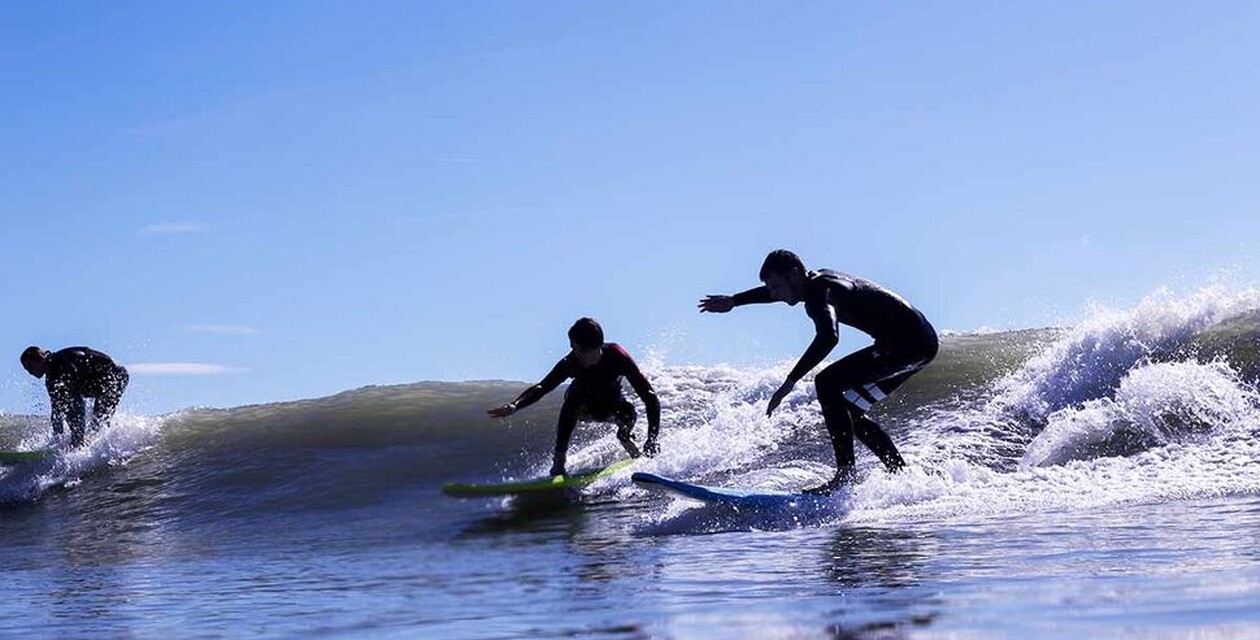
This is NOT the way to do it
A little anecdote about surfer Olaf
To make it clear to you what effects eye contact, raising your hand and apologizing have on you and on the mood of the whole line-up, here's a little case study. Something like this happened at a spot in this world:
There's a surfer, let's call him Olaf. Olaf woke up this morning in a bad mood because he had one too many beers yesterday. He runs to the beach because the forecast is promising. In fact, when he arrives at the beach, he can already see the most beautiful waves. The only bad thing is that there are already twenty people sitting on his favorite peak. No matter, he can't wait for waves like these. So he paddles out and positions himself in the line-up to surf. All the semi-pros are catching one wave after another, but Olaf has been paddling through the line-up for 30 minutes, over-motivated and unable to catch a wave. This doesn't necessarily improve his hangover mood. Finally, Olaf catches a wave, takes off and sees a perfect wall in front of him. His anticipation is immense. Suddenly he hears a shout from behind, which alerts him that he has just dropped someone. He thinks to himself: "Where did you come from"? In his haste, he had forgotten to check whether another surfer was sitting closer to the peak. Olaf surfs a few more meters and then angrily leaves the wave.
Olaf then paddles back into the line-up and, frustrated, decides not to apologize. Olaf pulls his head in, avoids eye contact and paddles a few metres away.
The other surfer is very angry: firstly, Olaf has destroyed the part of the wave where he was about to perform his most powerful maneuver and secondly, the guy hasn't even apologized. Of course, he immediately tells his cousin, who also surfs this spot with him every day. "The dude with the orange wetsuit just dropped into my best wave and didn't even apologize!"
30 minutes later: Olaf, still without a satisfying ride, sees his moment has come. A set wave rolls in. He looks around, he's sitting right at the peak. 10 meters further on, sitting on the shoulder of the wave, his cousin looks towards the peak and sees Olaf doing the take-off. He thinks to himself: "Hey, that's the guy with the orange neo who dropped in on my cousin Herbert earlier. What does he think he's doing - on our beach?" The cousin paddles for the wave and drops Olaf in and surfs the wave to the end. Olaf now blows his fuses: He paddles towards the cousin and starts shouting at him. Herbert joins in and the shouting gets even louder: "You dropped in on me before too! A fight breaks out.
Of course, the other surfers notice. The argument over a wave signals to the other surfers: Oh, apparently there aren't enough waves, I have to be more aggressive to catch waves. The good mood is gone, the surfers become tense and make the wrong decisions because they fear for their wave yield. The atmosphere in the line-up is poisoned and only because Olaf decided not to apologize in the previous situation. Eye contact, a hand raise and sorry would have been enough to prevent the scenario. So if you want to surf in the line-up, follow the rules or apologize afterwards. Then no one will be angry.
3. greet the other surfers in the line-up
When surfing in the line-up, it is important to communicate with other surfers. When you paddle into the lay-up, make eye contact and greet others with a nod, a smile or a "hi". You will see that most people will smile back and be happy about it.
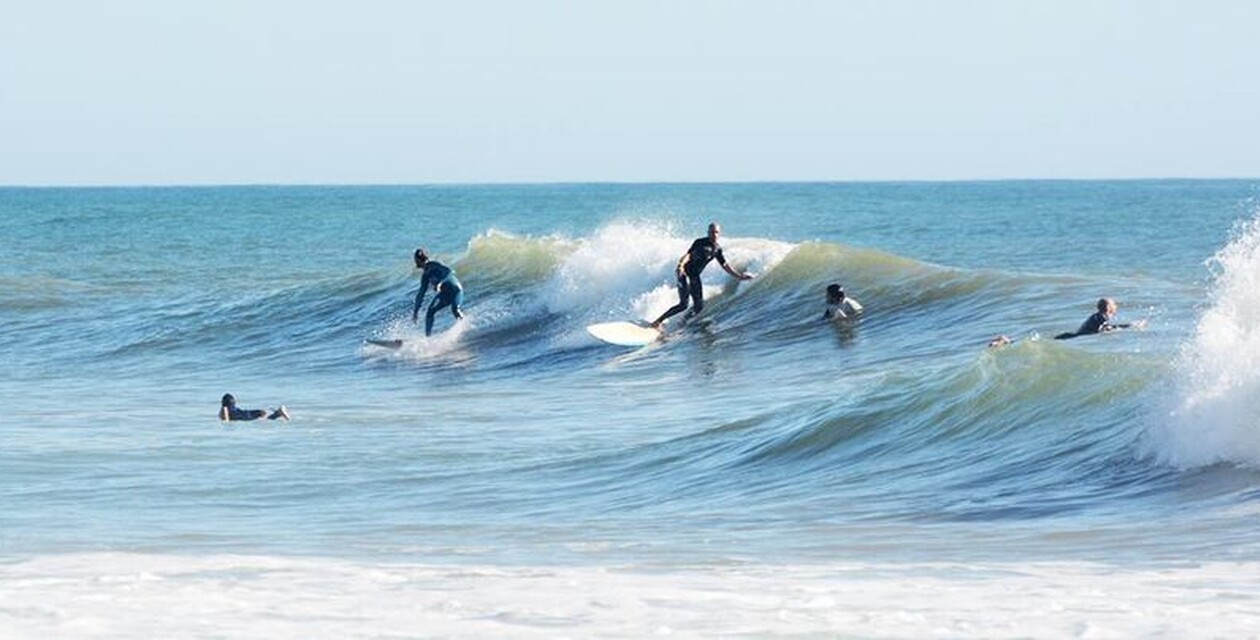
4. communicate with the other surfers
Communication is everything. Especially if you want to surf a wave in pairs. There are waves that break in a so-called A-frame, i.e. on both sides. In theory, two surfers can surf these waves at the same time. One surfer surfs to the right and the other surfs to the left. So if you paddle into an A-frame wave at the peak together with another surfer, communicate with the other surfer: "I go left" or "where are you going?" (or vice versa). (or vice versa). Surfing a wave too far only works if you talk to each other beforehand. Don't be shy about doing this. It signals that you know the rules and that you are optimizing your wave yield.
Watch out for good surfers: With very good surfers, it can happen that they take off behind the peak and then ride in the "wrong" direction. This is intentional because they want to attack the powerful peak or because they are looking for a tube. This is often only possible if you do the take-off behind the peak. This also gives these surfers priority because they have the opportunity to ride the wave the longest. That's why you should communicate in such situations. The surfer will often shout out loud that it's better to get out of the way now. This is also a way of communicating, albeit not so politely ;-)
5. paddle to the broken wave
You want to surf in the line-up and first have to paddle into the line-up. Especially at beach breaks, it can often happen that the peaks wander and you don't always find the perfect way back into the line-up. You paddle a wide arc around the peak. Nevertheless, a wave suddenly pops up in front of you and a surfer surfs towards you. Now what?
In order not to disturb the surfer, you should avoid paddling quickly over the shoulder of the wave. You have to bite the bullet and paddle into the already broken part of the wave, towards the peak in the white water. Most of the time you'll be washed through again. At least if you haven't yet got the right technique. This is a very noble gesture and is also noticed by the surfer surfing the wave. He now knows that you know the rules, respect them and in some circumstances the better surfers will give you waves when they have made their cut. Surf karma... :)
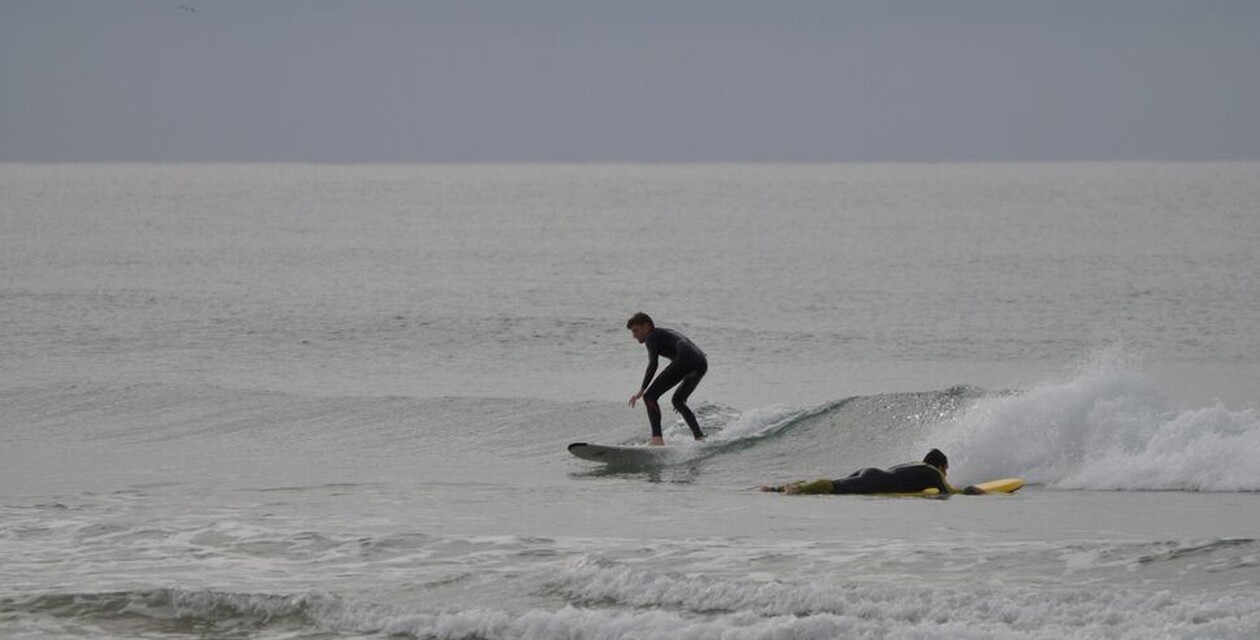
6. paddle in an arc around the peak back into the line-up
If you have just surfed down a wave or fallen, you should avoid simply paddling straight back into the line-up. This can put you in the way of the next surfer. You also put yourself and your surfboard in danger.
In addition to the peak, there are often channels (currents) that help you to get back to the line-up quickly and easily. If you do get in someone's way or paddle over the shoulder of the wave, forcing another surfer to choose a different line, remember our rule number 2: Apologize.
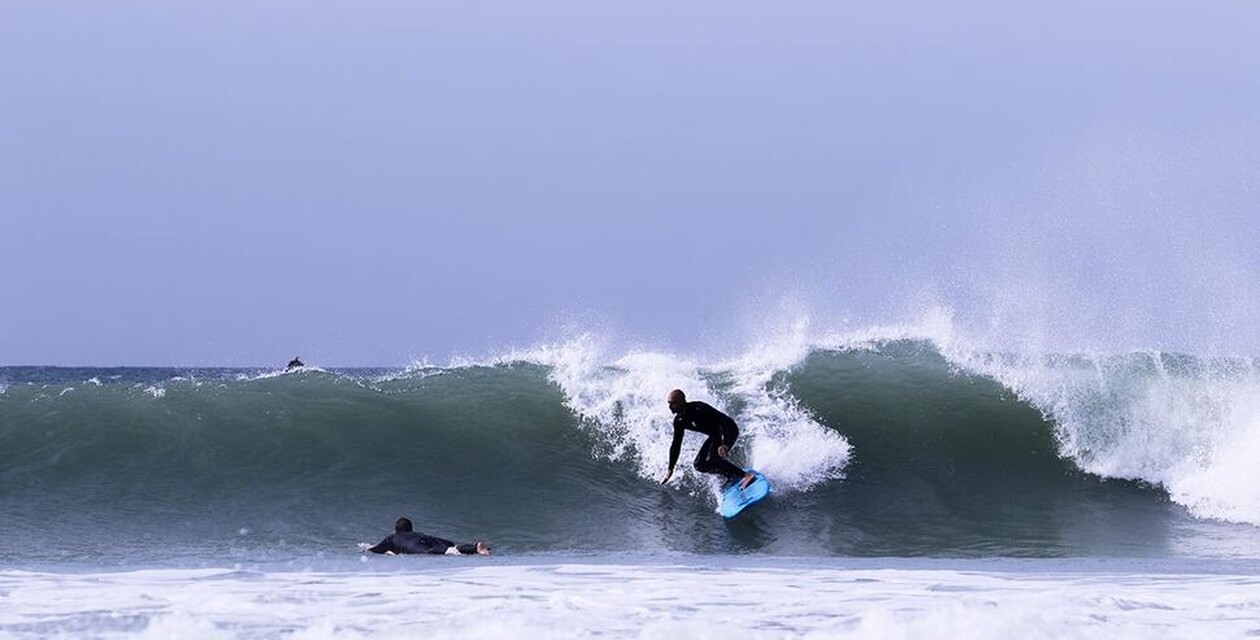
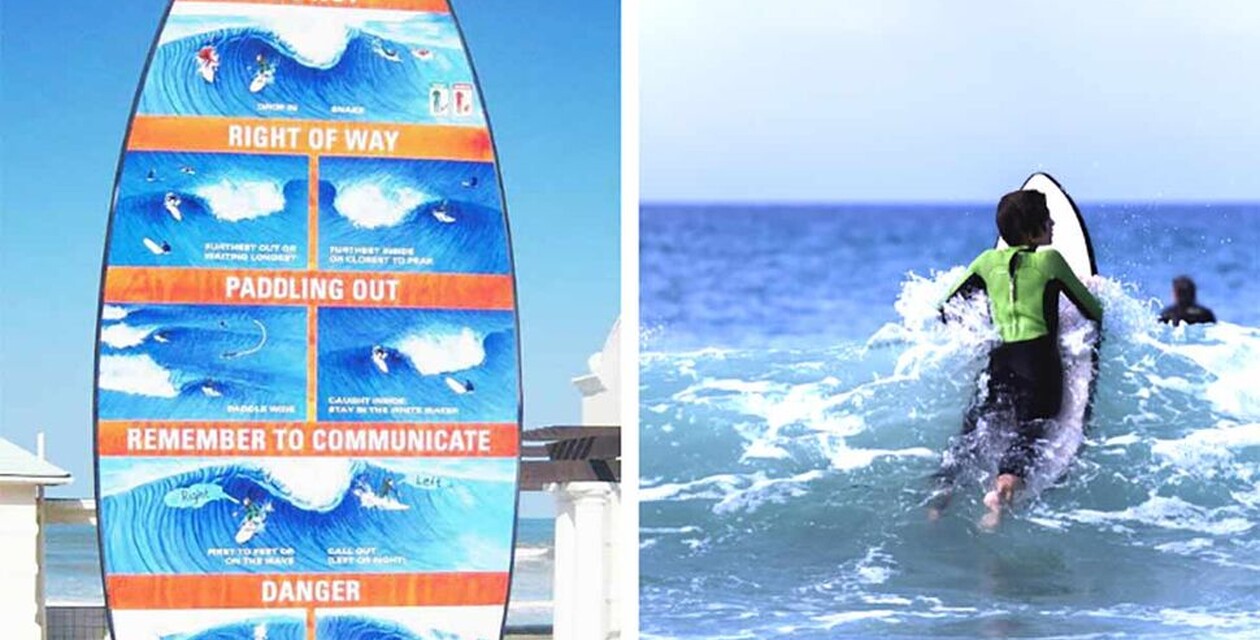
7. don't paddle on every wave (Don't Snowball)
If you want to surf in the line-up, you naturally want to catch as many waves as possible. Time and again, we see surfers paddling into every wave in the hope that the surfer with the right of way won't catch it. You shouldn't do this, because even if you pull your surfboard back in time, you may cause the wave to break prematurely. This is called the snowball effect, because the white water destroys the green wave like a snowball. You should really only do this if you have accidentally overlooked someone who has priority. Especially in steep and hollow waves, it's not cool to paddle into the wave if you can already see that another surfer has priority. You destroy the opportunity to use the wave to its full potential, i.e. to ride a powerful turn or a possible tube section. If you see that someone is already paddling in priority position for the wave, stay relaxed on your surfboard and let them have the wave. Especially with good surfers, you can assume that they will get the wave anyway.

8. don't snake
A popular technique for gaining priority is the so-called "snaking". Imagine a surfer paddling towards the wave at the peak and obviously has the priority position. The so-called snaker paddles around the surfer at the last moment, so is now closer to the peak and takes priority. This is not a nice gesture. This cheeky move is usually performed by good, aggressive surfers in crowded line ups. If you have several surfers like this around you, it's better to change the peak or surf the inside wave - if available. Because surfing with aggressive surfers is not much fun. If there is a local or other experienced surfers in the line-up, you may be lucky and the snakers will be reprimanded. If not, it's more relaxed to avoid the situation.
9. leave the waves to other surfers too
There are days when you are always in the right position, the waves always seem to come to you and you surf wave after wave. Longboarders in particular generally have more waves than surfers with shortboards due to their volume and length advantage. Longboarders are also able to plane the wave and take off earlier, which automatically gives them priority. Our tip in this case: once you've had your fill of a few waves, slow down a little and let the others have the waves too. Because at some point, the surfers around you will get bored and start dropping in on you. They want to tell you: "We're still here too!" So it's best to show everyone the necessary respect and let set waves through from time to time. Especially if you have just repositioned yourself at the peak after a long ride.
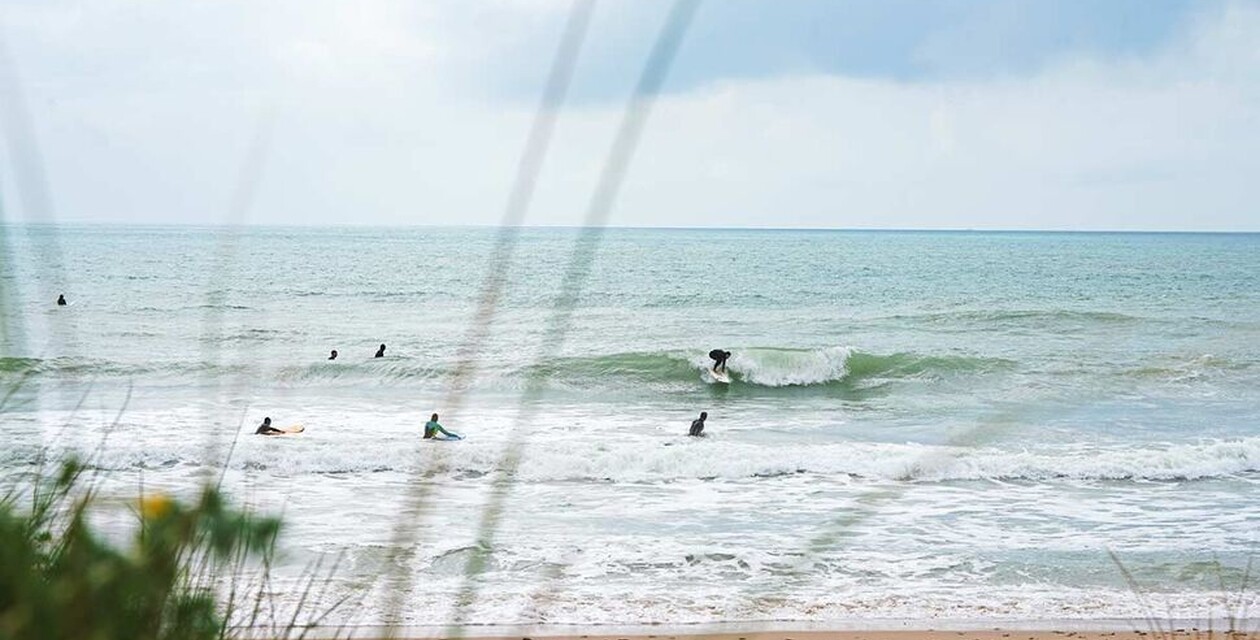
10. find a surf spot for your skill level
Before you go surfing in the line-up, check the surf spot. When you arrive at the beach, try to do a surf spot check first. This will make it easier for you to assess whether a surf spot is suitable for you. If you're not sure, talk to other surfers, lifeguards or locals at the spot.
Many spots can be fun on days with small swells. Small and gentle waves are more predictable and don't break as violently. Ideal for beginners! On big days, the character of a surf spot can change. Where waist-high waves rolled in the day before, you suddenly only see overhead-high, hollow breakers. In such a case, you should think carefully about whether to venture into the water.
Current danger: On big days, there can be a strong current that makes swimming in the open sea dangerous - unless you are fit enough and have no knowledge of currents. It is not uncommon for inexperienced surfers to panic and have to be "rescued" by other surfers.
Of course, when surfing you have to push your limits from time to time and move out of your comfort zone. Otherwise you won't develop as a surfer. But only take these steps if you feel mentally capable of doing so and are physically up to it. On days when you're not sure, watch the waves and other surfers for longer than usual. This will help you decide whether it makes sense for you to surf today or not. If in doubt, take a break from surfing.
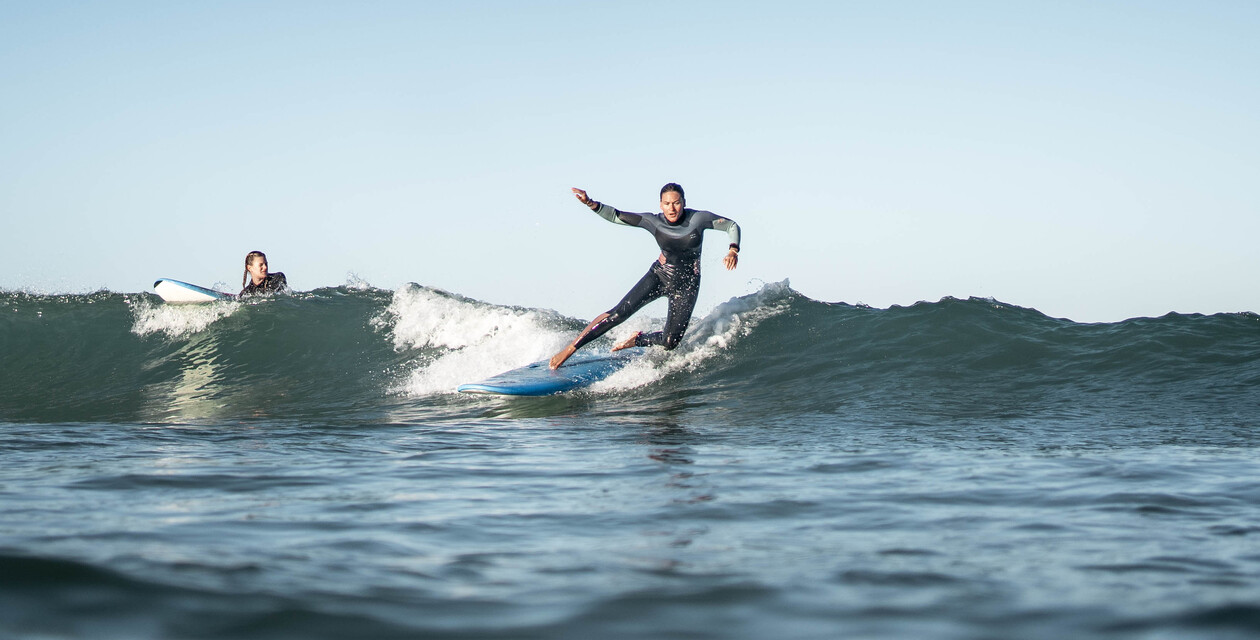
11. Control your surfboard
A flying surfboard can pose a danger to you and other surfers. If you haven't yet mastered the dipping techniques perfectly, it can be difficult to keep your board with you in big waves. Boards flying around are not welcome and should be the exception. So always try to keep your surfboard under control.
On days with big waves, you will probably have to part with your board more often if you are not yet ready for it and have not yet mastered the appropriate diving techniques (such as the duck dive). In this case, the so-called chicken dive is recommended. In a chicken dive, you pass the board backwards and dive under the wave without the board. The board is connected to you via the leash. This works great, but should not be done too often. Especially on big days, this technique poses four major dangers - for you, for others and for your wallet:
Your flying board may hit someone behind you. So check beforehand whether there is anyone in your immediate vicinity.
The leash can break due to the strong pull on the leash when diving through the big waves. This is very dangerous because you then have to return to the beach without your board. An abandoned board can also pose an immense danger to others.
There are surf spots with rocks on the beach. A stray board can be severely damaged by the stones.
The force of the wave can "snap" the surfboard. This means that the lip of the wave breaks through the middle of the board and it is broken. Bringing two broken parts of a surfboard ashore undamaged can be difficult. If you are traveling with rental equipment, you will also have to pay for the damage.
So always make sure to surf in line-up conditions where you can keep control of your surfboard.
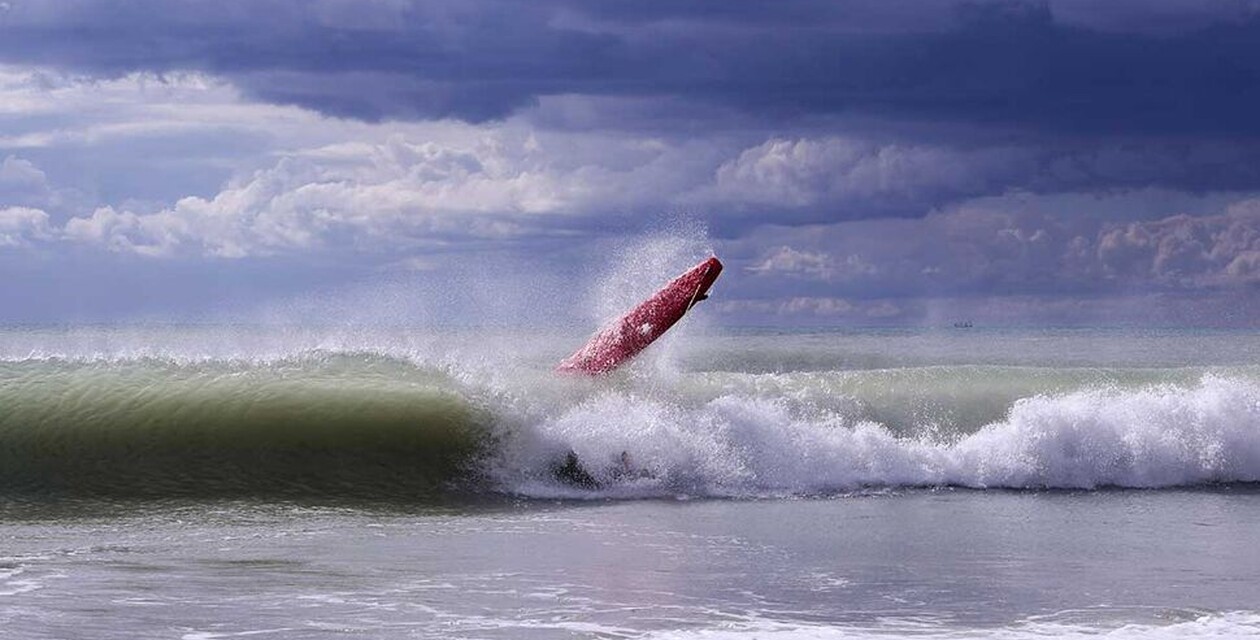
12. respect the locals
Locals are often feared. Often wrongly so, because if you surf "their" line-up with respect and understanding, you won't have any problems in the water. Locals are surfers who have grown up at a surf spot or people who have been surfing in an area for a very long time. Surfing is becoming more and more popular and as a result you occasionally come across frustrated locals who don't want to understand why their empty surf spots are suddenly getting fuller. It's even somewhat understandable. For you, this means: be even more sensitive to the rules of surfing etiquette and try to behave correctly and respectfully. If you've had a wave, stand at the back of the line-up and don't paddle straight back to the peak.
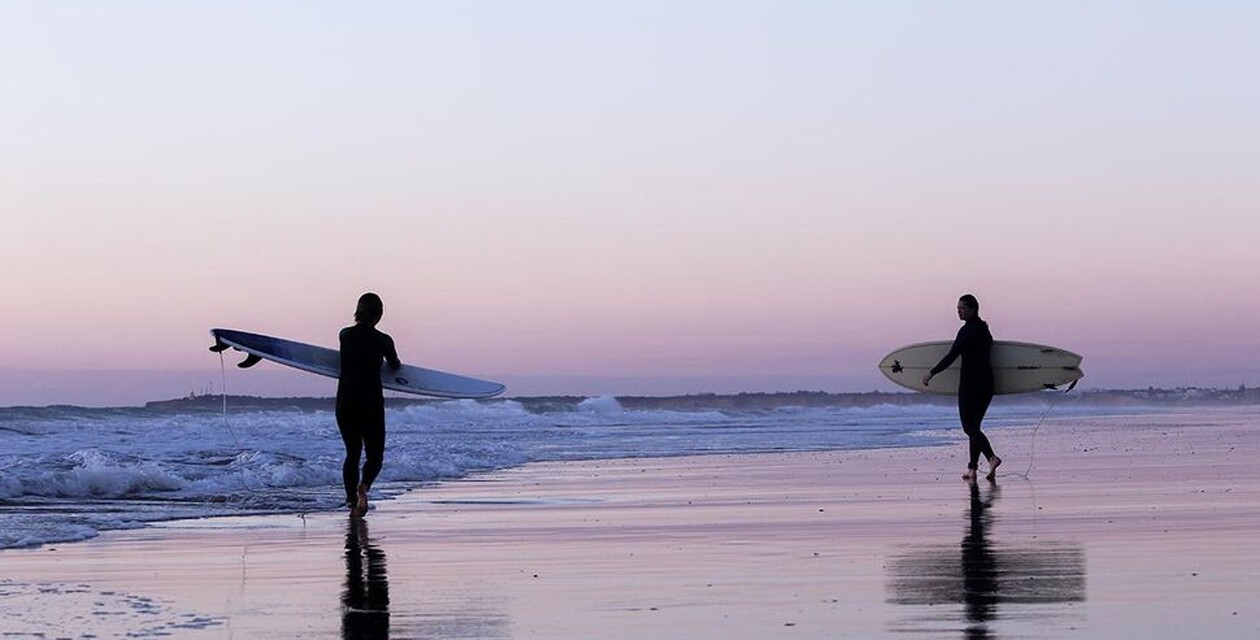
13. come to the surf spot in a small group
It is also awkward to paddle into the line-up with a large group of friends, position yourselves immediately at the peak and perhaps even talk loudly in German. This kind of behavior will certainly not win you the sympathy of the local surfers. If you are in a group, try to enter the water at a distance and position yourselves on the shoulder first. Greet the other surfers in a friendly manner when you arrive at the line-up and talk to each other discreetly. Then you should have no problems and a good surf. Surfing in the line-up always has something to do with respect and politeness.
14. have fun surfing!
After all, the best surfer is the one who has the most fun riding the waves. :-)

Get into the line-up while surfing
Now you know all the rules of surfing etiquette and how you should behave in the line-up to avoid making enemies. But how do you get into the line-up in the first place?
How it can work
There is no general answer to this question, as every surf spot is different and every day brings different conditions. These are our tips:
It's usually a little easier on a reef because the waves only break over the reef and you can paddle comfortably around it until you get to the line-up.
On days with small waves and little current, it's also not that difficult on a beach break. Then you can look for a so-called channel or simply paddle over the small waves. If you can do a duckdive, you can dive through it.
If there is a big swell on a day, it can be quite tricky to get into the line-up. It's best to only do this if you're feeling good and confident. Often you can't get into the line-up without a duck dive. Sometimes, however, you can make it with the right timing - and a lot of willpower.
Conclusion Surf rules
You realize that there are many different rules if you want to surf in the line-up. These are necessary to guarantee every surfer the best possible time in the water. If you unintentionally break a rule or have a mishap, it's no problem at all - it happens all the time - as long as you apologize afterwards. Nobody is perfect and, especially when surfing, you sometimes find yourself in situations where you simply can't act 100% correctly or lack experience at the beginning. That's why it's all the more important to know surf etiquette and integrate it into your surfing step by step. This will make you a better surfer and you'll get more waves in the end. We wish you lots of fun surfing respectfully in the line-up.
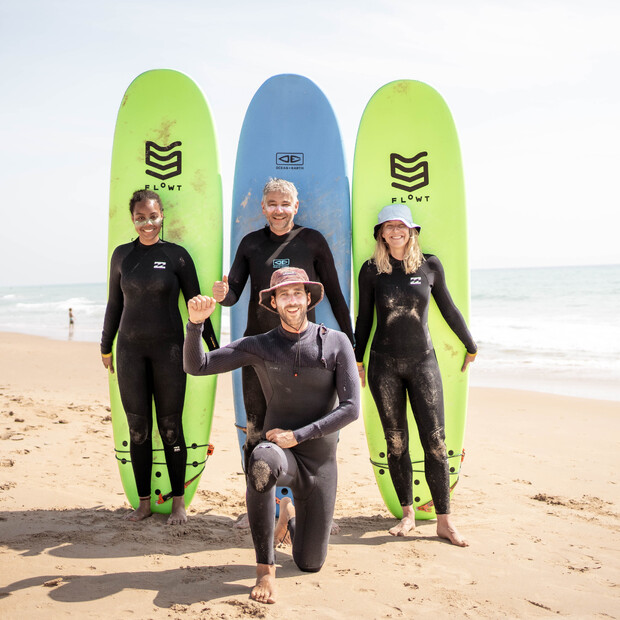
Surfing yourself now?
Visit the A-Frame surf camp in El Palmar and become part of the surf community yourself. Both beginners and advanced surfers are welcome in our surf courses. Look forward to beautiful waves, great food and nice like-minded people.